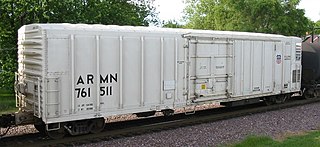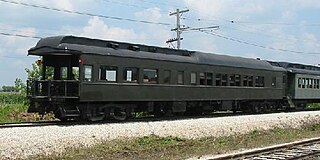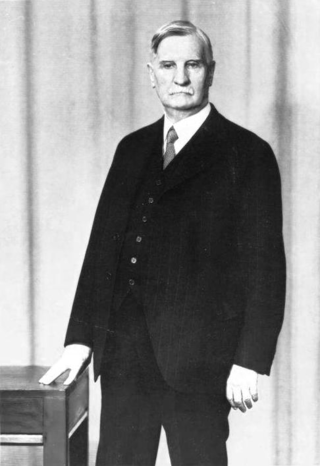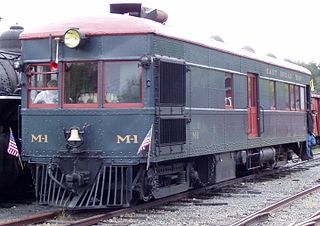Related Research Articles

A railcar is a self-propelled railway vehicle designed to transport passengers. The term "railcar" is usually used in reference to a train consisting of a single coach, with a driver's cab at one or both ends. Some railway companies, such as the Great Western, termed such vehicles "railmotors".

The Chicago, Milwaukee, St. Paul and Pacific Railroad (CMStP&P), better known as the Milwaukee Road, was a Class I railroad that operated in the Midwest and Northwest of the United States from 1847 until 1986.

A streamliner is a vehicle incorporating streamlining in a shape providing reduced air resistance. The term is applied to high-speed railway trainsets of the 1930s to 1950s, and to their successor "bullet trains". Less commonly, the term is applied to fully faired upright and recumbent bicycles. As part of the Streamline Moderne trend, the term was applied to passenger cars, trucks, and other types of light-, medium-, or heavy-duty vehicles, but now vehicle streamlining is so prevalent that it is not an outstanding characteristic. In land speed racing, it is a term applied to the long, slender, custom built, high-speed vehicles with enclosed wheels.

The Hiawathas were a fleet of named passenger trains operated by the Chicago, Milwaukee, St. Paul and Pacific Railroad between Chicago and various destinations in the Midwest and Western United States. The most notable of these trains was the original Twin Cities Hiawatha, which served the Twin Cities in Minnesota. The train was named for the epic poem The Song of Hiawatha by Henry Wadsworth Longfellow.

A refrigerator car is a refrigerated boxcar (U.S.), a piece of railroad rolling stock designed to carry perishable freight at specific temperatures. Refrigerator cars differ from simple insulated boxcars and ventilated boxcars, neither of which are fitted with cooling apparatus. Reefers can be ice-cooled, come equipped with any one of a variety of mechanical refrigeration systems, or utilize carbon dioxide as a cooling agent. Milk cars may or may not include a cooling system, but are equipped with high-speed trucks and other modifications that allow them to travel with passenger trains.

A dome car is a type of railway passenger car that has a glass dome on the top of the car where passengers can ride and see in all directions around the train. It also can include features of a coach, lounge car, dining car, sleeping car or observation. Beginning in 1945, dome cars were primarily used in the United States and Canada, though a small number were constructed in Europe for Trans Europ Express service.

An observation car/carriage/coach is a type of railroad passenger car, generally operated in a passenger train as the rearmost carriage, with windows or a platform on the rear of the car for passengers' viewing pleasure. The cars were nearly universally removed from service on American railroads beginning in the 1950s as a cost-cutting measure in order to eliminate the need to "turn" the trains when operating out of stub-end terminals.

ACF Industries, originally the American Car and Foundry Company, is an American manufacturer of railroad rolling stock. One of its subsidiaries was once (1925–54) a manufacturer of motor coaches and trolley coaches under the brand names of (first) ACF and (later) ACF-Brill. Today, the company is known as ACF Industries LLC and is based in St. Charles, Missouri. It is owned by investor Carl Icahn.
The St. Louis Car Company was a major United States manufacturer of railroad passenger cars, streetcars, interurbans, trolleybuses and locomotives that existed from 1887 to 1974, based in St. Louis, Missouri.

The Budd Company was a 20th-century metal fabricator, a major supplier of body components to the automobile industry, and a manufacturer of stainless steel passenger rail cars, airframes, missile and space vehicles, and various defense products.

The Pioneer Zephyr is a diesel-powered trainset built by the Budd Company in 1934 for the Chicago, Burlington & Quincy Railroad (CB&Q), commonly known as the Burlington Route. The trainset was the second internal combustion-powered streamliner built for mainline service in the United States, the first such train powered by a diesel engine, and the first to enter revenue service.

Edward Gowen Budd was an American inventor and businessman.

The Olympian and its successor the Olympian Hiawatha were passenger trains operated by the Chicago, Milwaukee, St. Paul and Pacific Railroad between Chicago and the Pacific Northwest. The Olympian operated from 1911 to 1947 and was, along with its running mate the Columbian, the first all-steel train to operate in the Pacific Northwest. The streamlined Olympian Hiawatha operated from 1947 to 1961 and was one of several Milwaukee Road trains to carry the name "Hiawatha". The Olympian Hiawatha was designed by industrial designer Brooks Stevens and included the distinctive glassed-in "Skytop" observation-sleeping cars. It later featured full-length "Super Dome" cars.

Otto August Kuhler was an American designer, one of the best known industrial designers of the American railroads. According to Trains magazine he streamstyled more locomotives and railroad cars than Cret, Dreyfuss and Loewy combined. His extensive concepts for the modernization of the American railroads have repercussions onto the railways worldwide until today. In addition he was a prolific artist of industrial aesthetics and of the American West in general.

Doodlebug or hoodlebug is a nickname in the United States for a type of self-propelled railcar most commonly configured to carry both passengers and freight, often dedicated baggage, mail or express, as in a combine. The name is said to have derived from the insect-like appearance of the units, as well as the slow speeds at which they would doddle or "doodle" down the tracks. Early models were usually powered by a gasoline engine, with either a mechanical drive train or a generator providing electricity to traction motors ("gas-electrics"). In later years, it was common for doodlebugs to be repowered with a diesel engine.

The Columbian was a named passenger train operated by the Chicago, Milwaukee, St. Paul and Pacific Railroad between Chicago, Illinois, and Seattle/Tacoma, Washington. The westbound train was Milwaukee Road train #17, and the eastbound train was train #18. It was launched on Monday, May 29, 1911. The same day, the faster, limited-stop and more luxurious Olympian also launched. These were the first passenger trains to take advantage of the Milwaukee Road Pacific Extension, which had opened to freight in 1909.

A vehicle frame, also historically known as its chassis, is the main supporting structure of a motor vehicle to which all other components are attached, comparable to the skeleton of an organism.

The Twin Cities Hiawatha, often just Hiawatha, was a named passenger train operated by the Chicago, Milwaukee, St. Paul and Pacific Railroad, and traveled from Chicago to the Twin Cities. The original train takes its name from the epic poem The Song of Hiawatha by Henry Wadsworth Longfellow. There are a number of Hiawatha-themed names within the city of Minneapolis, the terminus of the original train. The first Hiawatha ran in 1935; in 1939 the Milwaukee Road introduced a second daily trip between Chicago and Minneapolis. The two trains were known as the Morning Hiawatha and Afternoon Hiawatha, or sometimes the AM Twin Cities Hiawatha and PM Twin Cities Hiawatha. The Milwaukee Road discontinued the Afternoon Hiawatha in 1970 while the Morning Hiawatha continued running until the formation of Amtrak in 1971.

The Super Dome was a Dome car built by Pullman-Standard for the Chicago, Milwaukee, St. Paul and Pacific Railroad in 1952. The ten Super Domes were the first full-length dome cars in revenue service, first operating on the Olympian Hiawatha and Twin Cities Hiawatha in late 1952. Although a mixed blessing in passenger use, the cars garnered much publicity for the Milwaukee Road and several remain in operation.
The El Camino was a set of lightweight streamlined railcars owned by Los Angeles County in the 1970s and 1980s. The county acquired the cars to bootstrap a proposed commuter rail service between Los Angeles and Orange County. This effort, spearheaded by County Supervisor Baxter Ward, was unsuccessful. The equipment saw limited use on Amtrak's San Diegan in 1978 and was sold in 1985.
References
- ↑ August Derleth, The Milwaukee Road: Its First Hundred Years, Creative Age Press, New York, 1948, p. 261
- ↑ The Milwaukee Magazine, published by the Chicago, Milwaukee, St. Paul and Pacific Railway Company, July 1947, p. 10
- ↑ The Milwaukee Magazine, published by the Chicago, Milwaukee, St. Paul and Pacific Railway, July 1947, p. 7-13